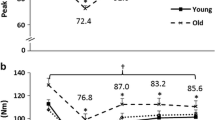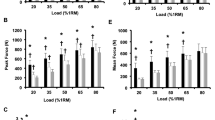Abstract
The purpose of the present study was to determine: (1) if different acute neuromuscular responses occur between constant versus variable external resistance machines, two commonly used resistance machines and (2) whether the potential differences in fatigability between young and older men influence the magnitude of acute response between these resistance machines. Twelve young men (28 ± 5 year) and 13 older men (65.4 ± 4 year) performed 15 × 1 repetition maximum and 5 × 10 repetitions isotonic knee extension resistance loadings with both constant and variable resistance (four loadings in total). Maximum isometric knee extension torque, superimposed twitch, resting twitch torque, maximal M wave properties, electromyograph, and blood lactate concentration measured the effects of loading. Concentric torque reduced to a greater extent during variable 15 × 1 versus constant loading in young men only (P < 0.05). While three out of the four loadings caused decreased voluntary activation in young men, only 15 × 1 using variable resistance caused reductions in older men (P < 0.05). 5 × 10 variable resistance loading significantly increased M wave duration and decreased EMG median frequency, which was not observed following constant resistance loading in both age groups. Acute decreases in force production were significantly greater in young men following all loading protocols (P < 0.05). Both young and older men showed indications of greater fatigue from variable resistance loadings. Differing muscle properties may have led to different magnitudes of fatigue between groups, and older subjects may benefit from specifically tailored training programs.





Similar content being viewed by others
References
Ahtiainen JP, Hoffren M, Hulmi JJ, Pietikäinen M, Mero AA, Avela J, Häkkinen K (2010) Panoramic ultrasonography is a valid method to measure changes in skeletal muscle cross-sectional area. Eur J Appl Physiol 108(2):273–279
Allman BL, Rice CL (2001) Incomplete recovery of voluntary isometric force after fatigue is not affected by old age. Muscle Nerve 24(9):1156–1167
Allman BL, Rice CL (2002) Neuromuscular fatigue and aging: central and peripheral factors. Muscle Nerve 25(6):785–796
Allman BL, Rice CL (2003) Perceived exertion is elevated in old age during an isometric fatigue task. Eur J Appl Physiol 89(2):191–197
Baudry S, Klass M, Pasquet B, Duchateau J (2007) Age-related fatigability of the ankle dorsiflexor muscles during concentric and eccentric contractions. Eur J Appl Physiol 100(5):515–525
Bigland-Ritchie B, Johansson R, Lippold OC, Woods JJ (1983) Contractile speed and EMG changes during fatigue of sustained maximal voluntary contractions. J Neurophysiol 50(1):313–324
Brody LR, Pollock MT, Roy SH, De Luca CJ, Celli B (1991) pH-induced effects on median frequency and conduction velocity of the myoelectric signal. J Appl Physiol 71(5):1878–1885
Callahan DM, Kent-Braun JA (2011) Effect of old age on human skeletal muscle force-velocity and fatigue properties. J Appl Physiol 111(5):1345–1352
Callahan DM, Foulis SA, Kent-Braun JA (2009) Age-related fatigue resistance in the knee extensor muscles is specific to contraction mode. Muscle Nerve 39(5):692–702
Campos GE, Luecke TJ, Wendeln HK et al (2002) Muscular adaptations in response to three different resistance-training regimens: specificity of repetition maximum training zones. Eur J Appl Physiol 88(1–2):50–60
Christie A, Snook EM, Kent-Braun JA (2011) Systematic review and meta-analysis of skeletal muscle fatigue in old age. Med Sci Sports Exerc 43(4):568–577
Dalton BH, Power GA, Vandervoort AA, Rice CL (2012) The age-related slowing of voluntary shortening velocity exacerbates power loss during repeated fast knee extensions. Exp Gerontol 47(1):85–92
Gorostiaga EM, Navarro-Amezqueta I, Cusso R et al (2010) Anaerobic energy expenditure and mechanical efficiency during exhaustive leg press exercise. PlosOne 5(10):e13486
Häkkinen K (1995) Neuromuscular fatigue and recovery in women at different ages during heavy resistance loading. Electromyogr Clin Neurophysiol 35(7):403–413
Häkkinen K, Pakarinen A (1995) Acute hormonal responses to heavy resistance exercise in men and women at different ages. Int J Sports Med 16(8):507–513
Häkkinen K, Komi PV, Kauhanen H (1987) Scientific evaluation of specific loading of the knee extensors with variable resistance, “isokinetic” and barbell exercises. Med Sport Sci 26:224–237
Häkkinen K, Kauhanen H, Komi PV (1988) Effects of fatiguing loading with variable resistance equipment on neural activation and force production of the knee extensor muscles. Electromyogr Clin Neurophysiol 28:79–87
Häkkinen K, Newton RU, Gordon SE et al (1998) Changes in muscle morphology, electromyographic activity, and force production characteristics during progressive strength training in young and older men. J Gerontol A Biol Sci Med Sci 53(6):B415–B423
Herbert RD, Gandevia SC (1999) Twitch interpolation in human muscles: mechanisms and implications for measurement of voluntary activation. J Neurophysiol 82(5):2271–2283
Hermens HJ, Freriks B, Merletti R et al (1999) European recommendations for surface electromyography, results of the SENIAM project 1999. Roessingh Research and Development, Enschede, pp 44–46
Hunter SK, Todd G, Butler JE, Gandevia SC, Taylor JL (2008) Recovery from supraspinal fatigue is slowed in old adults after fatiguing maximal isometric contractions. J Appl Physiol 105(4):1199–1209
Judelson DA, Maresh CM, Farrell MJ et al (2007) Effect of hydration state on strength, power, and resistance exercise performance. Med Sci Sports Exerc 39(10):1817–1824
Juel C (1988) Muscle action potential propagation velocity changes during activity. Muscle Nerve 11(7):714–719
Kulig K, Andrews JG, Hay JG (1984) Human strength curves. Exerc Sport Sci Rev 12:417–466
Lanza IR, Russ DW, Kent-Braun JA (2004) Age-related enhancement of fatigue resistance is evident in men during both isometric and dynamic tasks. J Appl Physiol 97(3):967–975
Lanza IR, Befroy DE, Kent-Braun JA (2005) Age-related changes in ATP-producing pathways in human skeletal muscle in vivo. J Appl Physiol 99(5):1736–1744
Lieber RL, Friden J (1993) Muscle damage is not a function of muscle force but active muscle strain. J Appl Physiol 74(2):520–526
McBride TA, Stockert BW, Gorin FA, Carlsen RC (2000) Stretch-activated ion channels contribute to membrane depolarization after eccentric contractions. J Appl Physiol 88(1):91–101
McNeil CJ, Rice CL (2007) Fatigability is increased with age during velocity-dependent contractions of the dorsiflexors. J Gerontol A Biol Sci Med Sci 62(6):624–629
Merton PA (1954) Voluntary strength and fatigue. J Physiol 123(3):553–564
Moritani T, deVries HA (1980) Potential for gross muscle hypertrophy in older men. J Gerontol. 35(5):672–682
Newton RU, Häkkinen K, Häkkinen A, McCormick M, Volek J, Kraemer WJ (2002) Mixed-methods resistance training increases power and strength of young and old men. Med Sci Sports Exerc 34(8):1367–1375
Peterson MD, Sen A, Gordon PM (2011) Influence of resistance exercise on lean body mass in aging adults: a meta-analysis. Med Sci Sports Exerc 43(2):249–258
Petrella JK, Kim J-S, Tuggle SC, Hall SR, Bamman MM (2005) Age differences in knee extension power, contractile velocity, and fatigability. J Appl Physiol 98(1):211–220
Stackhouse SK, Stevens JE, Lee SC, Pearce KM, Snyder-Mackler L, Binder-Macleod SA (2001) Maximum voluntary activation in nonfatigued and fatigued muscle of young and elderly individuals. Phys Ther 81(5):1102–1109
Walker S, Taipale RS, Nyman K, Kraemer WJ, Häkkinen K (2011) Neuromuscular and hormonal responses to constant and variable resistance loadings. Med Sci Sports Exerc 43(1):26–33
Walker S, Davis L, Avela J, Häkkinen K (2012) Neuromuscular fatigue during dynamic maximal strength and hypertrophic resistance loadings. J Electromyogr Kinesiol 22(3):356–362
Yamada H, Okada M, Oda T, Nemoto S, Shiozaki T, Kizuka T, Kuno S, Masuda T (2000) Effects of aging on EMG variables during fatiguing isometric contractions. J Hum Ergol 29(1–2):7–14
Yoon T, Schlinder De-Lap B, Griffith EE, Hunter SK (2008) Age-related muscle fatigue after a low-force fatiguing contraction is explained by central fatigue. Muscle Nerve 37(4):457–466
Acknowledgments
The authors wish to thank the subjects for their efforts during this study. We also acknowledge the contribution of Pirkko Puttonen during data analysis. This work was funded in part by the Department of Biology of Physical Activity, University of Jyväskylä and by personal grants to Simon Walker from The National Doctoral Program of Musculoskeletal Disorders and Biomaterials, Finland and the Rector of the University of Jyväskylä, Finland.
Conflict of interest
All authors declare no conflicts of interest.
Author information
Authors and Affiliations
Corresponding author
Additional information
Communicated by Toshio Moritani.
Rights and permissions
About this article
Cite this article
Walker, S., Peltonen, H., Avela, J. et al. Neuromuscular fatigue in young and older men using constant or variable resistance. Eur J Appl Physiol 113, 1069–1079 (2013). https://doi.org/10.1007/s00421-012-2526-2
Received:
Accepted:
Published:
Issue Date:
DOI: https://doi.org/10.1007/s00421-012-2526-2




